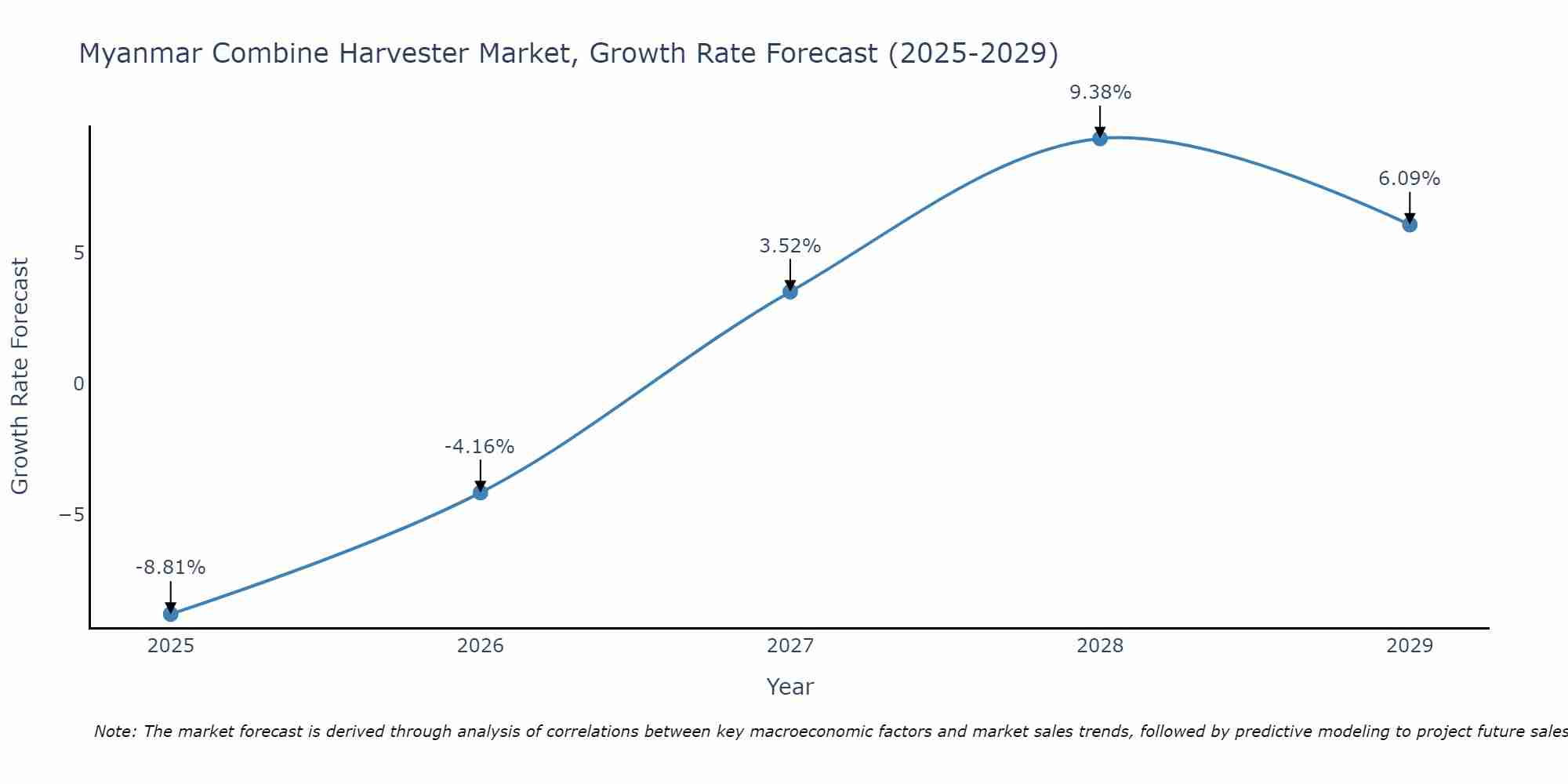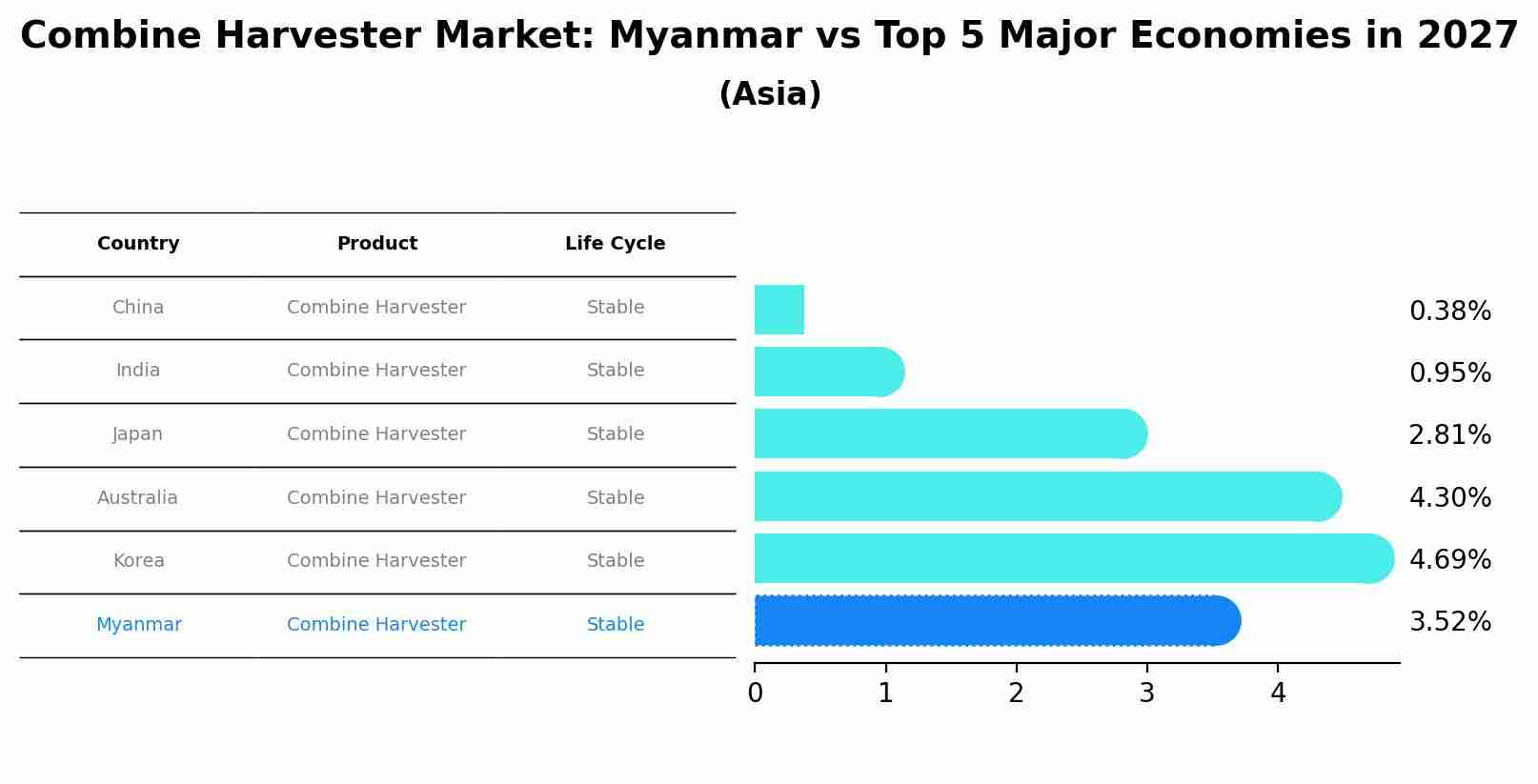Myanmar Combine Harvester Market Outlook | Industry, Revenue, Trends, COVID-19 IMPACT, Growth, Companies, Analysis, Size, Share, Value & Forecast
| Product Code: ETC428730 | Publication Date: Oct 2022 | Updated Date: Aug 2025 | Product Type: Market Research Report | |
| Publisher: 6Wresearch | Author: Shubham Padhi | No. of Pages: 75 | No. of Figures: 35 | No. of Tables: 20 |
Myanmar Combine Harvester Market Size Growth Rate
The Myanmar Combine Harvester Market is projected to witness mixed growth rate patterns during 2025 to 2029. The growth rate begins at -8.81% in 2025, climbs to a high of 9.38% in 2028, and moderates to 6.09% by 2029.

Combine Harvester Market: Myanmar vs Top 5 Major Economies in 2027 (Asia)
By 2027, the Combine Harvester market in Myanmar is anticipated to reach a growth rate of 3.52%, as part of an increasingly competitive Asia region, where China remains at the forefront, supported by India, Japan, Australia and South Korea, driving innovations and market adoption across sectors.

Myanmar Combine Harvester Market Overview
The Myanmar combine harvester market is experiencing steady growth, fueled by the mechanization of agriculture and the increasing adoption of modern farming techniques. Combine harvesters offer significant advantages in terms of efficiency, productivity, and labor savings, making them increasingly popular among farmers. As Myanmar aims to boost agricultural productivity and reduce post-harvest losses, the demand for combine harvesters is expected to rise, especially among large-scale commercial farms.
Drivers of the market
The agricultural sector in Myanmar is witnessing a shift towards mechanization to improve productivity and efficiency. The growing adoption of combine harvesters, driven by factors such as labor shortages, rising labor costs, and government initiatives to promote modern farming practices, is fueling market growth.
Challenges of the market
In the Myanmar combine harvester market, challenges include limited mechanization in agriculture, which reduces the demand for advanced harvesting equipment. The predominantly small-scale nature of farming operations and the lack of access to finance constrain farmers` ability to invest in modern machinery. Moreover, inadequate infrastructure for after-sales support and spare parts distribution complicates the maintenance and repair of combine harvesters. Additionally, variability in crop types and terrain conditions across different regions present engineering challenges for manufacturers.
Government Policy of the market
Agricultural policies in Myanmar greatly influence the combine harvester market. Government initiatives to boost agricultural productivity through mechanization support the adoption of modern farming equipment, including combine harvesters. Subsidies, loans, and training programs provided by the government to farmers facilitate market growth.
Key Highlights of the Report:
- Myanmar Combine Harvester Market Outlook
- Market Size of Myanmar Combine Harvester Market, 2024
- Forecast of Myanmar Combine Harvester Market, 2031
- Historical Data and Forecast of Myanmar Combine Harvester Revenues & Volume for the Period 2018 - 2031
- Myanmar Combine Harvester Market Trend Evolution
- Myanmar Combine Harvester Market Drivers and Challenges
- Myanmar Combine Harvester Price Trends
- Myanmar Combine Harvester Porter's Five Forces
- Myanmar Combine Harvester Industry Life Cycle
- Historical Data and Forecast of Myanmar Combine Harvester Market Revenues & Volume By Cutting Width for the Period 2018 - 2031
- Historical Data and Forecast of Myanmar Combine Harvester Market Revenues & Volume By Small Size Combine Harvester for the Period 2018 - 2031
- Historical Data and Forecast of Myanmar Combine Harvester Market Revenues & Volume By Large Size Combine Harvester for the Period 2018 - 2031
- Historical Data and Forecast of Myanmar Combine Harvester Market Revenues & Volume By Type for the Period 2018 - 2031
- Historical Data and Forecast of Myanmar Combine Harvester Market Revenues & Volume By Wheel Type Combine Harvester for the Period 2018 - 2031
- Historical Data and Forecast of Myanmar Combine Harvester Market Revenues & Volume By Crawler Type Combine Harvester for the Period 2018 - 2031
- Historical Data and Forecast of Myanmar Combine Harvester Market Revenues & Volume By Power Source for the Period 2018 - 2031
- Historical Data and Forecast of Myanmar Combine Harvester Market Revenues & Volume By Tractor Pulled/PTO Powered Combine Harvester for the Period 2018 - 2031
- Historical Data and Forecast of Myanmar Combine Harvester Market Revenues & Volume By Self-Propelled Combine Harvester for the Period 2018 - 2031
- Myanmar Combine Harvester Import Export Trade Statistics
- Market Opportunity Assessment By Cutting Width
- Market Opportunity Assessment By Type
- Market Opportunity Assessment By Power Source
- Myanmar Combine Harvester Top Companies Market Share
- Myanmar Combine Harvester Competitive Benchmarking By Technical and Operational Parameters
- Myanmar Combine Harvester Company Profiles
- Myanmar Combine Harvester Key Strategic Recommendations
Frequently Asked Questions About the Market Study (FAQs):
1 Executive Summary |
2 Introduction |
2.1 Key Highlights of the Report |
2.2 Report Description |
2.3 Market Scope & Segmentation |
2.4 Research Methodology |
2.5 Assumptions |
3 Myanmar Combine Harvester Market Overview |
3.1 Myanmar Country Macro Economic Indicators |
3.2 Myanmar Combine Harvester Market Revenues & Volume, 2021 & 2031F |
3.3 Myanmar Combine Harvester Market - Industry Life Cycle |
3.4 Myanmar Combine Harvester Market - Porter's Five Forces |
3.5 Myanmar Combine Harvester Market Revenues & Volume Share, By Cutting Width, 2021 & 2031F |
3.6 Myanmar Combine Harvester Market Revenues & Volume Share, By Type, 2021 & 2031F |
3.7 Myanmar Combine Harvester Market Revenues & Volume Share, By Power Source, 2021 & 2031F |
4 Myanmar Combine Harvester Market Dynamics |
4.1 Impact Analysis |
4.2 Market Drivers |
4.2.1 Government initiatives to promote mechanization in agriculture |
4.2.2 Increasing demand for higher efficiency in farming practices |
4.2.3 Growth of the agricultural sector in Myanmar |
4.3 Market Restraints |
4.3.1 Limited access to finance for farmers to invest in combine harvesters |
4.3.2 High initial investment and maintenance costs of combine harvesters |
4.3.3 Lack of awareness and technical skills among farmers regarding the use of combine harvesters |
5 Myanmar Combine Harvester Market Trends |
6 Myanmar Combine Harvester Market, By Types |
6.1 Myanmar Combine Harvester Market, By Cutting Width |
6.1.1 Overview and Analysis |
6.1.2 Myanmar Combine Harvester Market Revenues & Volume, By Cutting Width, 2021-2031F |
6.1.3 Myanmar Combine Harvester Market Revenues & Volume, By Small Size Combine Harvester, 2021-2031F |
6.1.4 Myanmar Combine Harvester Market Revenues & Volume, By Large Size Combine Harvester, 2021-2031F |
6.2 Myanmar Combine Harvester Market, By Type |
6.2.1 Overview and Analysis |
6.2.2 Myanmar Combine Harvester Market Revenues & Volume, By Wheel Type Combine Harvester, 2021-2031F |
6.2.3 Myanmar Combine Harvester Market Revenues & Volume, By Crawler Type Combine Harvester, 2021-2031F |
6.3 Myanmar Combine Harvester Market, By Power Source |
6.3.1 Overview and Analysis |
6.3.2 Myanmar Combine Harvester Market Revenues & Volume, By Tractor Pulled/PTO Powered Combine Harvester, 2021-2031F |
6.3.3 Myanmar Combine Harvester Market Revenues & Volume, By Self-Propelled Combine Harvester, 2021-2031F |
7 Myanmar Combine Harvester Market Import-Export Trade Statistics |
7.1 Myanmar Combine Harvester Market Export to Major Countries |
7.2 Myanmar Combine Harvester Market Imports from Major Countries |
8 Myanmar Combine Harvester Market Key Performance Indicators |
8.1 Adoption rate of combine harvesters in the agricultural sector |
8.2 Average yield per acre of farms using combine harvesters compared to traditional methods |
8.3 Rate of increase in farm productivity after the introduction of combine harvesters |
9 Myanmar Combine Harvester Market - Opportunity Assessment |
9.1 Myanmar Combine Harvester Market Opportunity Assessment, By Cutting Width, 2021 & 2031F |
9.2 Myanmar Combine Harvester Market Opportunity Assessment, By Type, 2021 & 2031F |
9.3 Myanmar Combine Harvester Market Opportunity Assessment, By Power Source, 2021 & 2031F |
10 Myanmar Combine Harvester Market - Competitive Landscape |
10.1 Myanmar Combine Harvester Market Revenue Share, By Companies, 2024 |
10.2 Myanmar Combine Harvester Market Competitive Benchmarking, By Operating and Technical Parameters |
11 Company Profiles |
12 Recommendations |
13 Disclaimer |
- Single User License$ 1,995
- Department License$ 2,400
- Site License$ 3,120
- Global License$ 3,795
Search
Thought Leadership and Analyst Meet
Our Clients
Related Reports
- Germany Breakfast Food Market (2026-2032) | Industry, Share, Growth, Size, Companies, Value, Analysis, Revenue, Trends, Forecast & Outlook
- Australia Briquette Market (2025-2031) | Growth, Size, Revenue, Forecast, Analysis, Trends, Value, Share, Industry & Companies
- Vietnam System Integrator Market (2025-2031) | Size, Companies, Analysis, Industry, Value, Forecast, Growth, Trends, Revenue & Share
- ASEAN and Thailand Brain Health Supplements Market (2025-2031) | Strategy, Consumer Insights, Analysis, Investment Trends, Opportunities, Growth, Size, Share, Industry, Revenue, Segments, Value, Segmentation, Supply, Forecast, Restraints, Outlook, Competition, Drivers, Trends, Demand, Pricing Analysis, Competitive, Strategic Insights, Companies, Challenges
- ASEAN Bearings Market (2025-2031) | Strategy, Consumer Insights, Analysis, Investment Trends, Opportunities, Growth, Size, Share, Industry, Revenue, Segments, Value, Segmentation, Supply, Forecast, Restraints, Outlook, Competition, Drivers, Trends, Demand, Pricing Analysis, Competitive, Strategic Insights, Companies, Challenges
- Europe Flooring Market (2025-2031) | Outlook, Share, Industry, Trends, Forecast, Companies, Revenue, Size, Analysis, Growth & Value
- Saudi Arabia Manlift Market (2025-2031) | Outlook, Size, Growth, Trends, Companies, Industry, Revenue, Value, Share, Forecast & Analysis
- Uganda Excavator, Crane, and Wheel Loaders Market (2025-2031) | Strategy, Consumer Insights, Analysis, Investment Trends, Opportunities, Growth, Size, Share, Industry, Revenue, Segments, Value, Segmentation, Supply, Forecast, Restraints, Outlook, Competition, Drivers, Trends, Demand, Pricing Analysis, Competitive, Strategic Insights, Companies, Challenges
- Rwanda Excavator, Crane, and Wheel Loaders Market (2025-2031) | Strategy, Consumer Insights, Analysis, Investment Trends, Opportunities, Growth, Size, Share, Industry, Revenue, Segments, Value, Segmentation, Supply, Forecast, Restraints, Outlook, Competition, Drivers, Trends, Demand, Pricing Analysis, Competitive, Strategic Insights, Companies, Challenges
- Kenya Excavator, Crane, and Wheel Loaders Market (2025-2031) | Strategy, Consumer Insights, Analysis, Investment Trends, Opportunities, Growth, Size, Share, Industry, Revenue, Segments, Value, Segmentation, Supply, Forecast, Restraints, Outlook, Competition, Drivers, Trends, Demand, Pricing Analysis, Competitive, Strategic Insights, Companies, Challenges
Industry Events and Analyst Meet
Whitepaper
- Middle East & Africa Commercial Security Market Click here to view more.
- Middle East & Africa Fire Safety Systems & Equipment Market Click here to view more.
- GCC Drone Market Click here to view more.
- Middle East Lighting Fixture Market Click here to view more.
- GCC Physical & Perimeter Security Market Click here to view more.
6WResearch In News
- Doha a strategic location for EV manufacturing hub: IPA Qatar
- Demand for luxury TVs surging in the GCC, says Samsung
- Empowering Growth: The Thriving Journey of Bangladesh’s Cable Industry
- Demand for luxury TVs surging in the GCC, says Samsung
- Video call with a traditional healer? Once unthinkable, it’s now common in South Africa
- Intelligent Buildings To Smooth GCC’s Path To Net Zero


















